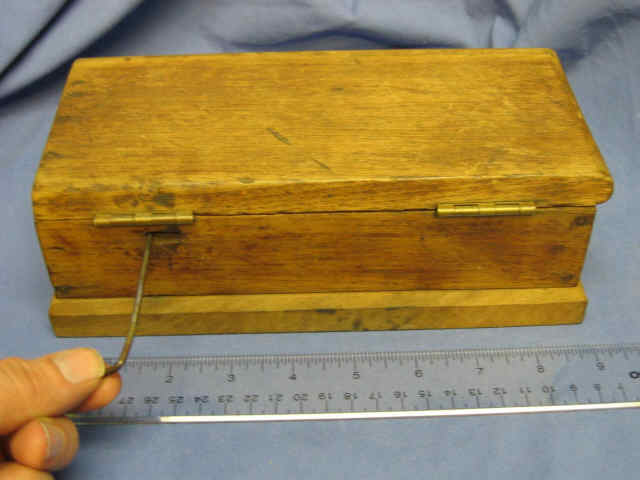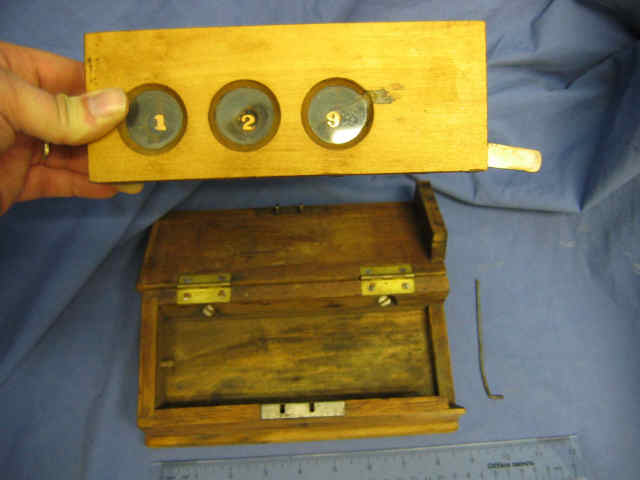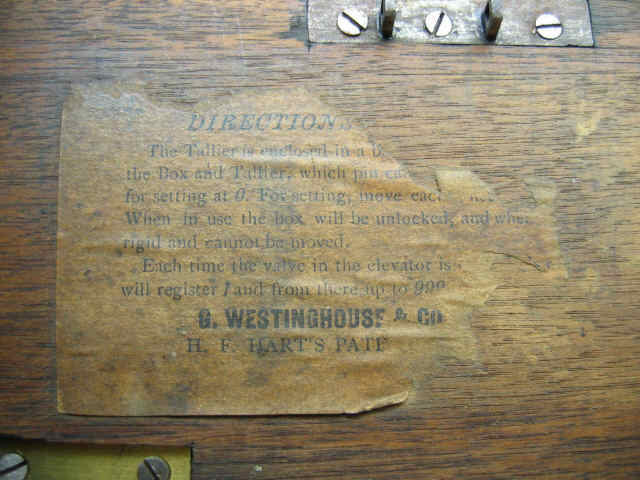G. Westinghouse & Co. Wooden Box Tally Register
Schenectady, N.Y. Circa 1870?
This neat wooden chest contains a mechanical tallier mounted on a wood plate with a mixture of brass and steel components. Each upward swing of the brass elevator (protruding from the right) advances the count by one. A simple gear tooth tens carry mechanism automatically advances the total from 0 to 999 across the three windows.
Here's a blurry video of this tallier in action:
(Can't see the play button? try refreshing your browser via the F5 key)
G. Westinghouse & Co. was an establishment of George Westinghouse Sr. of Schenectady, N.Y., father of the fabled inventor/industrialist George Westinghouse Jr. George Sr. owned a machine shop for agricultural and industrial applications (see 1874 flyer below).
This simple mechanical counting machine is a fascinating example of the transition from craftsman piecework in wood toward use of standardized gears and parts for mass production in metal.
Note how the wood is cut to offset the 3 gears in a saw-toothed fashion


In the picture below, you can see the tens carry mechanism of the mechanical counter, which is a single tooth projecting (out of the page, toward the viewer) from the middle gear at the twelve o'clock position and on the left gear at the three o'clock position. When the left gear next advances by one, it will engage the middle gear and advance it by one also, and this repeats every full rotation (10 steps) of the gear.
A numeral is painted on each gear tooth (on the side facing away from the viewer) so that the proper digit appears in each of the three windows when viewed from the front. A very simple and elegant design.

The partial text on the torn label says:
DIRECTIONS
The Tallier is enclosed in a b...
the Box and Tallier, which pin ca...
for setting at 0. For setting, move eac...
When in use the box will be unlocked and when...
rigid and cannot be moved.
Each time the valve in the elevator is...
will register 1 and from there up to 999 ...
G. WESTINGHOUSE & CO.
H. F. HART'S PATE...
G. Westinghouse & Co. circular and price list 1874 Schenectady, N.Y.
The company was apparently a market leader in threshing machines and horse powers (which I believe are steam engines with upright boilers on wheels).
Brian Szafranski offered the following note (thank you Brian):
Such devices where often used on an Automatic Weigher, which was a device mounted onto Threshing Machines, which the Westinghouse Co. of Schenectady, NY manufactured & sold.
Starting about 1880, Threshing Machines would be equipped with Automatic Weighers. These devices have a pipe routing the threshed grain into a Y Tube. The Y Tube had two outlets for the grain & a Diverter, as well as a device for weighing the bagged grain (so each bag was the same weight). When the weighing system registered a full bag, the person assigned to be the Bagger would divert the grain into the second outlet so that a second bag would be filling. The Bagger would tie closed the first bag of grain and set it aside. Automatic Weighers would sometimes be equipped with a Tallier.
This Tallier would count the number of bags of grain filled during the threshing operation at a farm. Staring in the early 1800’s, Threshing Teams went from farm to farm (most farmers couldn’t afford the machinery). With the Tallier, the Farmer could be shown exactly how many full bags of grain were threshed at his farm. Also, the Chief of the Threshing Team would record data into a Threshing Log Book: type of grain, farmer’s name & location, number of bags filled, full-bag weight, price per bag, and so forth.
.jpg)
H. F. Hart Odometer with locking mechanism circa 1870
The key turns a mechanism that prevents the gears turning.
H. F. Hart Odometer with 5 digits circa 1870
The elevator and spring-pins are missing, but the brass gears remain.